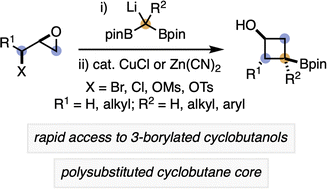Synthesis of 3-borylated cyclobutanols from epihalohydrins or epoxy alcohol derivatives†
Abstract
There is an increasing interest in cyclobutanes within the medicinal chemistry community. Therefore, methods to prepare cyclobutanes that contain synthetic handles for further elaboration are of interest. Herein, we report a new approach for the synthesis of 3-borylated cyclobutanols via a formal [3 + 1]-cycloaddition using readily accessible 1,1-diborylalkanes and epihalohydrins or epoxy alcohol derivatives. 1-Substituted epibromohydrin starting materials provide access to borylated cyclobutanols containing substituents at three of the four positions on the cyclobutane core, and enantioenriched epibromohydrins lead to enantioenriched cyclobutanols with high levels of enantiospecificity (>98%). Finally, derivatization studies demonstrate the synthetic utility of both the OH and Bpin handles.



 Please wait while we load your content...
Please wait while we load your content...